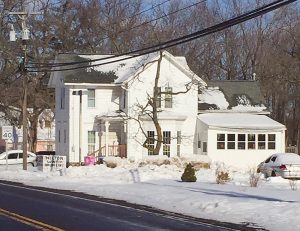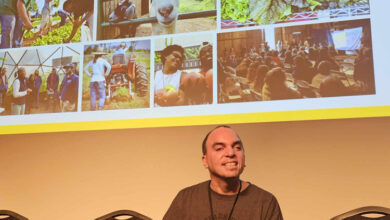History of Parma Center – Northeast Corner – Part 1 of 4
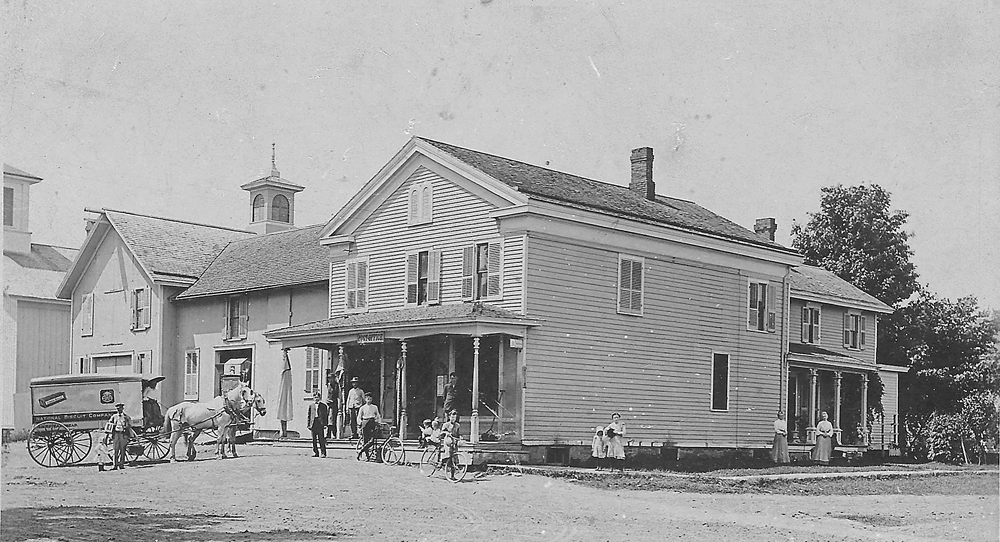
by David Crumb
Parma Town Historian
At the crossroads of Route 259 (the old Canawagus Indian Trail (so called in the days of the Seneca Indians) and the Parma Center Road, is the small hamlet of Parma Center. This junction is considered the center of Monroe County’s Town of Parma. Today drivers pass through the junction with the “blink of an eye.” The red light that slows drivers down at the intersection marks an integral location in Parma’s history.
Now turn your imaginations back to an earlier time. There were no asphalt roads … only dirt and gravel; no automobiles, only walking or if you were lucky a horse and wagon to ride on; no red stop light hanging over the intersection, and on all four corners there were significant buildings. Today only one of the original buildings still stands at the corners just as it did when it was built in 1831 by Austin Atchinson, one of the founders of the community. In this article I would like to give a brief history of each of those corners, the buildings that were once there, and some of the people that were the movers and shakers of Parma Center back when it was the business center of the township. Life unfolded at a much slower pace than we experience today, and the character of the community was quite pronounced.
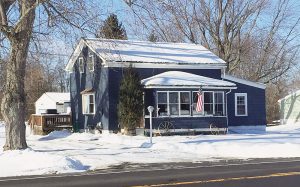
Parma Centre, as it was first spelled and noted on the early 1850 maps, was founded by two of the Atchinson brothers, Roswell and Austin in 1809. Their parents and relatives had been the first settlers in Braddock Bay Township (the early name before Parma) in 1796. The Atchinson settlement was the first permanent settlement west of the Genesee River, located just west of Parma Center at the bend of Hill Road near their cemetery, which is all that remains. In 1809, Roswell was 21 and Austin was 19. Roswell purchased the land south of Parma Center Road, and Austin purchased many acres on the north side of the road. Roswell’s first house is still standing on the west side of Route 259 going south, about a quarter mile from the Center opposite the entrance of the present Parma Town Hall.
Austin’s house, historically noted as the first house at the Center, was located on the northeast corner where a transmission shop operates today. There is some conjecture as to exactly when the house was built. In Shirley Cox Husted’s 1959 Pioneer Days, written for the Parma Sesquicentennial, she states “In 1809, 19-year-old Austin built Parma Center’s first house, on his northeast corner of the intersection. His old stone house was followed by a later house.” The Atchinson brothers were good leaders as the community began to grow; both religiously and politically. By the 1840s they both had moved on, having been financially successful in their early real estate ventures. The next generation of pioneer residents had arrived to take their places on improved land and in newly built homes.
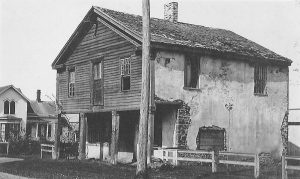
Northeast Corner: On this corner 19-year-old Austin built a stone and wood building used as a house, general store and post office. Some historians note a frame house built a few years later on the property. The exact dates for either of these buildings have yet to be determined. The 1852 map of Parma Centre shows a store and a house on the northeast corner. Ken Freeman, Curator of the Parma Hilton Museum, found an early floor plan of the house on the northeast corner which was among the Odell family papers. R.P. Odell purchased the old Atchinson farm in the 1860s and lived in the frame house which was later remodeled from its earlier configuration. He used the old stone and wood house for a workshop. The residence home was torn down in 1969 to make room for a service station. Today, the original historical tablet once marking the location is on display inside the transmission shop that presently occupies the site. The date for the house on this tablet states 1825.
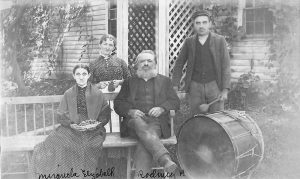
One of the earliest families, and longest to reside at Parma Centre, were the Odell’s. This family, of English origin, had been in New England for several generations and then migrated west to central New York. R.P. Odell Sr. settled in North Greece in the 1820s. North Greece was then called Jenkin’s Corners. His son, Rodney Putnam Odell Jr., was born in 1825.
He was called Putnam or R.P. His son, Guerdon Odell, left records of the family’s time in Parma Centre. Putnam was a robust young man and considered the champion wrestler and boxer of North Greece. At age 17, his parents sent him and his sister to Lima College in Lima, New York. Lima, the forerunner of Syracuse University, was a Methodist finishing school for young people whose parents wanted them to learn the classics, religion, practical business, along with good manners in order to become successful ladies and gentlemen.
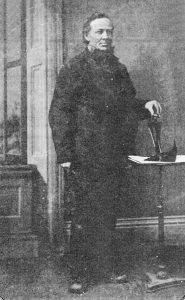
Around 1848 after finishing his education, R.P. Odell Jr. “got the itch” to see some of the world beyond Monroe County. While engaged in the tanning trade in Riga, some Boston capitalists offered to finance him on an expedition to the “gold diggings” in California. He accepted and to save money hired on as a crew member on the sailing ship that took him to Panama. There he crossed the Ismuths by land as the Panama Canal had not yet been built. On the Pacific shore he again hired on as crew for the second half of the trip to San Francisco. His time in Sacramento panning for gold did not pan out successfully (no pun intended) so he decided to head north to the new state of Oregon. While working as a ferryman on the Willamette River near Portland, he had an argument with seven rough-shod men who claimed they did not have the money to pay their fare. Prudently he collected fares midstream. The men asked him what he was going to do, and he said “swim to shore” as he knocked all seven overboard. Those boxing and wrestling skills from an earlier time served him well.
In 1853, R.P. Odell returned home. He moved to Parma Centre where he gained employment in Chauncy Knox’s general store as a clerk. Soon after, he met Chauncy’s daughter, Miranda, whom he later married. After a few years he took over ownership and management of the store. He purchased the old Atchinson farm of 50 acres on the northeast corner from Samuel Andrews. Later he acquired another 67 acres adjacent to the farm from Samuel Berridge. On this farm, he and Miranda raised their five children.
He became a leader in the community, becoming postmaster, running the general store, serving as a trustee of the Methodist Episcopal Church on the southeast corner, and serving as Town Clerk from 1854 to 1875, and then becoming Town Supervisor for four years. During the Civil War years when he was Town Clerk, he registered many of the Parma boys who had signed up for active duty in the Union Army. One soldier was his brother, Simeon, who fought for the Union and was stationed in Virginia. A few years after the war, Simeon returned to and settled in Virginia, liking the climate and agricultural opportunities there. There are several descendants of this Odell family still living in the Parma Hilton area.
Today, newer homes occupy the perimeter of the old Atchinson-Odell farm. The farm was purchased by Norman Almeter in 1947 and he initiated the development of modern one-story homes at that time. The old home that was reputed to be the earliest frame house north of the Ridge is gone, but not forgotten.
In the background of the old stone building that once stood at the corner is the home of Edwin Twentymon, an early Parma Center resident. Mr. Twentymon was an undertaker and had a coffin shop east of his house. In Parma Center lore, it has been noted that a tunnel went from the general store to the coffin shop, where slaves on the run from the South were hidden in coffins before making their way to Lake Ontario for the last segment of their journey on the Underground Railroad to freedom in Canada. Descendants of the Twentymons still reside in Parma.
Other early residents of the northeast corner, in addition to the Twentymons, were Thankful Ann Randall Collamer Burritt who moved to the center for convenience after outliving several husbands. William Denniston, a nephew of Edwin Twentymon and later proprietor of the Knox-Odell general store, lived on the first farm to the north of the Center by the creek on Route 259. He later became a New York State Legislator and was instrumental in the building and development of the Rochester Public Market.
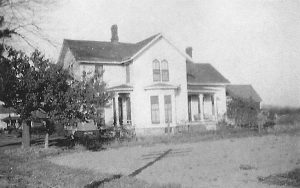
then (above) and today (below, photo by David Crumb)Watch for Part 2 on the Southeast Corner coming soon


